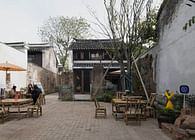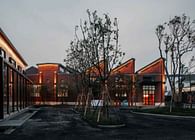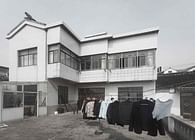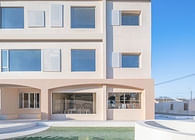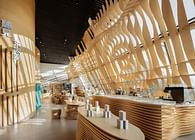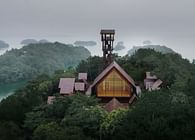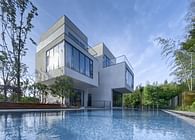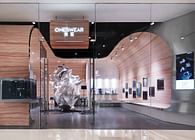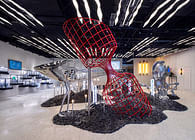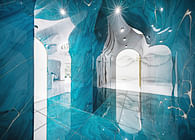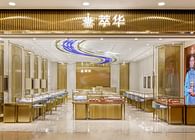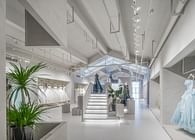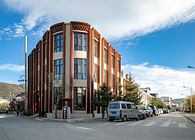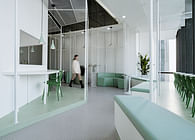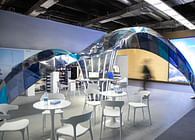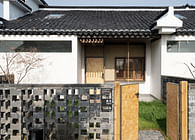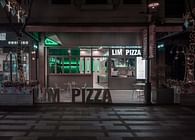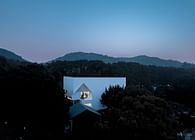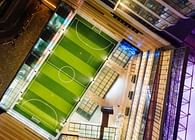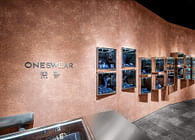
The site currently covers an area of about 1.5 mu (approximately 1,000 square meters), with the building occupying 600 square meters. It is a local courtyard-style structure that is now abandoned. Due to years of neglect, the roof, beams, and interior walls of the old brick-and-mortar structure have largely collapsed, posing some safety hazards. However, the exterior walls, built with traditional stone foundations from Xishan, remain mostly intact, with only partial damage. Within the courtyard, there are four tall and straight metasequoia trees, and outside the courtyard walls, there are five ancient camphor trees, approximately 500 years old, listed as national first-grade protected ancient trees. These trees provide a popular spot for locals to cool off and chat.
The project is named "Five Camphor Courtyard" after the site. Its significance is based on memory and the site itself. The juxtaposition of history, present, and future involves more than just considerations of ruins and renewal; it is about overlap and reconstruction. As new becomes old (the abandoned village school), and the old merges into time (the old garment factory walls), the newer (the Five Camphor Courtyard Cultural Salon) will reappear. This raises the challenge of the relationship between the new and old. The design is based on the characteristics of Jiangnan water village culture and classical garden culture in Suzhou, respecting history, integrating into the local context, inheriting culture, and creating value, to create a rural salon for the inheritance and development of Xishan's regional culture.
Memory is a cultural topic in rural projects. While discussing cultural heritage and restoring traditional buildings to preserve their shells may retain tangible heritage, intangible memories might need more attention. The future of rural areas might see prefabricated construction, energy conservation, environmental protection, and top-down community planning, but homogenization and commercialization are risks that need vigilance. Adapting to local conditions and creating places for differentiated lifestyles could be a strategy for this project.
The elements such as old walls, ancient camphor trees, the site of the Sheng Tang Temple, the garment factory, and the village school collectively form the cultural memory of generations of Xishan people. Although the main structure of the old buildings has collapsed, the surrounding walls are mostly intact, and the century-old camphor trees lend significant regional character. Interaction with the existing state is crucial in any architecture. The site’s unique atmosphere, along with the surrounding roads, ancient trees, old walls, Taihu Lake, and mountains, are considered in the design to create a building suitable for this region. Based on the current state of the old house and the site’s cultural memory, the design adopts a strategy of retaining the old walls while constructing new interiors. The new buildings will grow from the old walls, embodying the traditional residential characteristics of Suzhou.
The new building is set back to provide conditions for reinforcing the old walls. On the north side, near the ancient camphor trees, the building is entirely set back to meet the protection requirements of the ancient trees and to create courtyard space for visitors to appreciate the ancient camphor trees. On the south side, near Taihu Lake, the design includes a two-story height to capture views of the lake. To preserve the courtyard with the four tall metasequoias, the old courtyard structure is retained, and a linear volume is inserted according to building usage needs, with a folded roof to match the characteristics of Jiangnan water towns. The new building integrates humbly into the old walls, ancient camphor trees, and the village.
To minimize excavation depth and avoid damaging the roots of the ancient trees, the building adopts a raft foundation elevated by three steps above the original ground level, which also provides some moisture-proofing. The new building is separated from the old walls by at least 60 centimeters to ensure the new raft foundation and the reinforced foundation of the old walls do not interfere with each other, providing construction space and showing respect for history. Windows are included in the interior to connect with the weathered brick walls. The building uses a reverse beam structure to present a complete concrete folded surface effect on the second floor after the formwork is removed.
Based on the requirements for protecting the ancient trees, the metasequoias within the courtyard are retained, and hardening of the foundation is carried out to create a rest area for people to relax and engage in activities. The new buildings use white artistic exterior paint and dark gray aluminum-magnesium-manganese roofing, responding to the white walls and black tiles of Jiangnan residences in a contemporary way.
Ancient trees often have a unique sense of place. The juxtaposition of this historically memory-rich building and the five ancient trees creates an overlap of different spaces, generating more interesting spaces. This intersection conveys relationships between different historical memories and reflects the relationship between architecture and the environment. The choice to set back (within the old walls, outside the tree shade) shows respect and protection for history and the environment, while also aiming to weaken the formality of the new buildings, simplifying their exterior while enhancing the diversity of the interior space, integrating the buildings into the landscape with a humble posture.
Status: Built
Location: Jiangxi, CN







